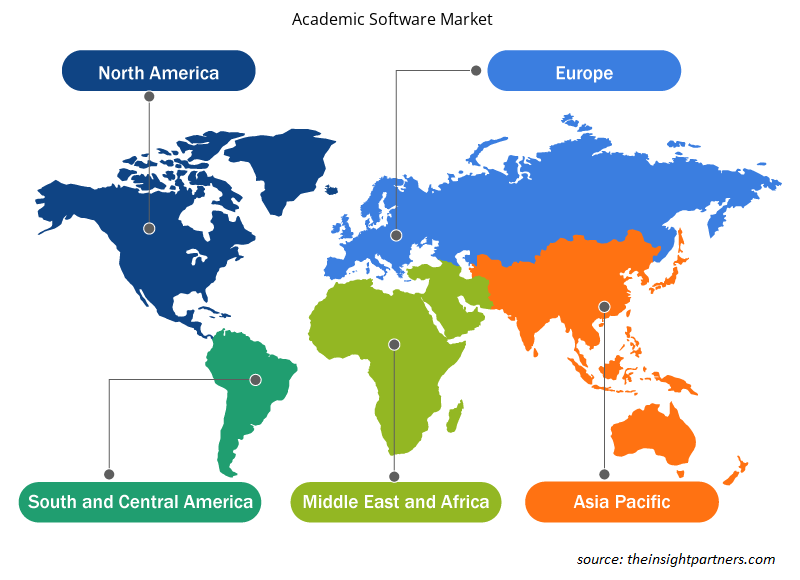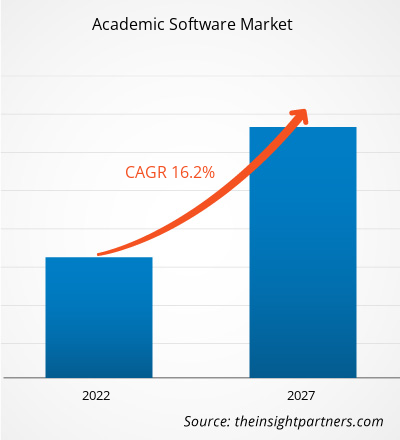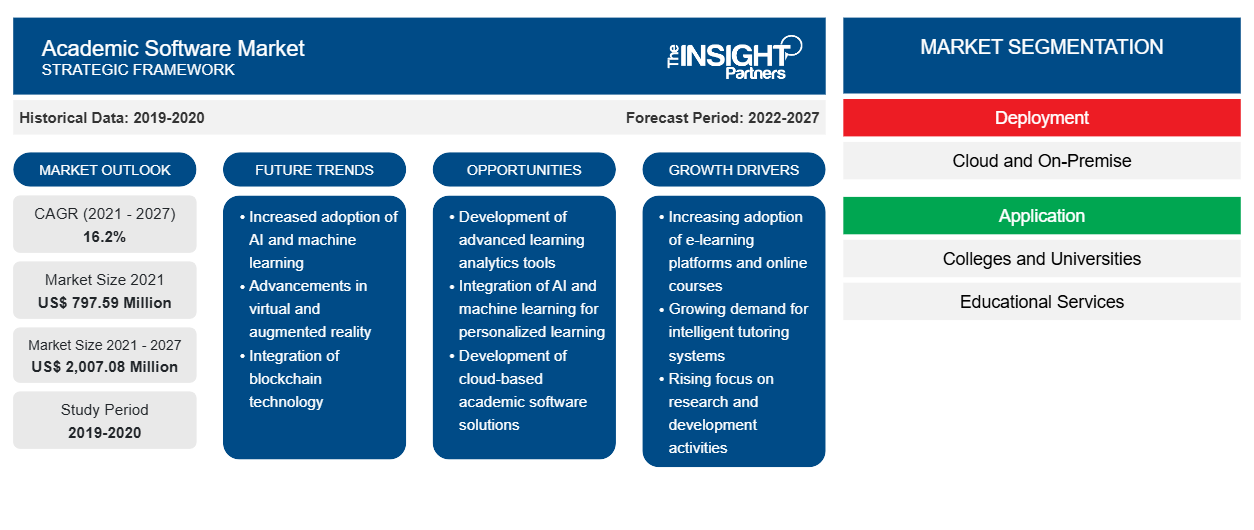学术软件市场预计将从 2021 年的 7.9759 亿美元增长到 2027 年的 20.0708 亿美元。预计在 2021 年至 2027 年的预测期内,学术软件市场将以 16.2% 的复合年增长率增长。
各机构越来越多地采用电子学习是推动学术软件市场增长的关键因素。在电子学习中,通过阅读或观看内容,它正在改变教育的传递方式。动画、播客和视频等多种电子学习课程创造了一种多模式、逼真的学习环境。电子学习、教育内容通过电脑、笔记本电脑、平板电脑或智能手机为学习者提供了多种沉浸式学习机会。学生不必处于被动的环境中,而是可以轻松快速地选择自己需要学习的内容。这些好处正在增加全球对学术软件的需求。
COVID-19 疫情严重影响了全球教育行业。这也推动了全球各主要经济体采用在线教育系统;从而影响了各种应用软件的采用,例如远程授课、管理学生和其他运营活动。因此,预计整个行业对技术先进解决方案的采用将对疫情期间学术软件市场的增长产生积极影响。
根据部署,学术软件市场分为云和本地。2019 年,云部分占据了更高的市场份额。近年来,技术行业稳步见证了云计算的采用大幅增长。这是因为云计算简化了实施时间并大幅降低了部署成本。这一优势吸引了大量最终用户;因此,大多数学术软件市场参与者都提供基于云的产品,以满足对基于云的软件日益增长的需求。此外,发达国家的互联网基础设施已经发展并在许多发展中国家蓬勃发展,使最终用户能够访问发达国家和发展中国家的基于云的解决方案
定制此报告以满足您的需求
您可以免费定制任何报告,包括本报告的部分内容、国家级分析、Excel 数据包,以及为初创企业和大学提供优惠和折扣
-
获取此报告的关键市场趋势。这个免费样品将包括数据分析,从市场趋势到估计和预测。
学术软件市场洞察
人工智能等技术与学术软件解决方案的融合
人工智能 (AI) 是一种技术,它使计算机能够像人类一样与人交流、理解事件、学习并对事件做出反应。多年来,人工智能不仅在各个行业(如安全、监控和信息技术)中得到了广泛的应用,而且在教育领域的应用也日益广泛。学校、学院和大学正在采用人工智能来自动执行重复性任务,如评分、财务分析和录取流程。例如,可以通过先进的计算机程序(如自动评分)对人工智能进行校准,以学习和模拟教师评分时的行为,以便将来自动评分。随着时间的推移,该程序将学习多名学生的学术技能,并根据他们的表现制定定制的培训计划。
基于部署的市场洞察
根据部署类型,全球学术软件市场分为云和本地。与本地学术软件相比,基于云的学术软件需求量很大。由于发达国家拥有强大的网络基础设施,云部分的成本相对较低,因此产生了大部分需求。此外,基于云的学术软件供应商高度专注于开发高级安全补丁,以消除网络攻击的风险。这一因素也产生了来自最终用户的巨大需求,从而推动了学术软件市场的发展。
基于应用的市场洞察
根据应用,学术软件市场分为高校、教育服务和其他。教育机构和大学越来越多地采用现代解决方案,为学生提供在线和离线课程,同时还积极向所有教职员工和学生提供先进的解决方案,这些都影响着学术软件的采用。多年来,这推动了市场的增长。
学术软件市场的参与者专注于市场计划、收购和产品发布等策略,以保持其在学术软件市场的地位。学术软件市场主要参与者的一些发展如下:
2020 年 12 月,Alma 学生信息系统平台引入了平均绩点 (GPA) 功能,该功能已添加到成绩册工具中。基于标准的评分 (SBG) 的根源在于将学生反馈和进度衡量与所教授和评估的特定技能相结合,而不是使用单一分数来涵盖多个主题或标准。
2020 年 7 月,ConexED 更新了其 iOS App 2.2.3,以提供更加用户友好的体验。该应用程序使学生、教职员工和教师能够在移动设备上加入虚拟会议和视频会议。
学术软件市场区域洞察
Insight Partners 的分析师已详细解释了预测期内影响学术软件市场的区域趋势和因素。本节还讨论了北美、欧洲、亚太地区、中东和非洲以及南美和中美洲的学术软件市场细分和地理位置。

- 获取学术软件市场的区域特定数据
学术软件市场报告范围
| 报告属性 | 细节 |
|---|---|
| 2021 年市场规模 | 7.9759亿美元 |
| 2027 年市场规模 | 20.0708亿美元 |
| 全球复合年增长率(2021 - 2027 年) | 16.2% |
| 史料 | 2019-2020 |
| 预测期 | 2022-2027 |
| 涵盖的领域 |
按部署
|
| 覆盖地区和国家 |
北美
|
| 市场领导者和主要公司简介 |
|
学术软件市场参与者密度:了解其对商业动态的影响
学术软件市场正在快速增长,其驱动力是终端用户需求的增加,而这些需求又源于消费者偏好的不断变化、技术进步以及对产品优势的认识不断提高等因素。随着需求的增加,企业正在扩大其产品范围,进行创新以满足消费者需求,并利用新兴趋势,从而进一步推动市场增长。
市场参与者密度是指在特定市场或行业内运营的企业或公司的分布情况。它表明在给定市场空间中,相对于其规模或总市场价值,有多少竞争对手(市场参与者)存在。
在学术软件市场运营的主要公司有:
- 阿尔玛
- 校园咖啡厅软件
- ConexED
- Envisio Solutions Inc.
- 全面料
免责声明:上面列出的公司没有按照任何特定顺序排列。

- 获取学术软件市场顶级关键参与者概览
学术软件市场 – 按部署
- 云
- 本地部署
学术软件市场 – 按应用分类
- 学院和大学
- 教育服务
- 其他的
学术软件市场 – 按地区划分
-
北美
- 我们
- 加拿大
- 墨西哥
-
欧洲
- 法国
- 德国
- 俄罗斯
- 英国
- 意大利
- 欧洲其他地区
-
亚太地区 (APAC)
- 中国
- 印度
- 日本
- 澳大利亚
- 韩国
- 亚太地区其他地区
-
中东及非洲
- 沙特阿拉伯
- 阿联酋
- 南非
- MEA 其他地区
-
山姆
- 巴西
- 阿根廷
- SAM 其余部分
学术软件市场 – 公司简介
- 阿尔玛
- 校园咖啡厅软件
- ConexED
- Envisio Solutions Inc.
- 全面料
- PowerVista 软件公司
- Qualtrics 有限责任公司
- Tophatmonocle 公司
- 真对话
- 威兹蜂巢
- 历史分析(2 年)、基准年、预测(7 年)及复合年增长率
- PEST和SWOT分析
- 市场规模、价值/数量 - 全球、区域、国家
- 行业和竞争格局
- Excel 数据集
近期报告
相关报告
客户评价
购买理由
- 明智的决策
- 了解市场动态
- 竞争分析
- 客户洞察
- 市场预测
- 风险规避
- 战略规划
- 投资论证
- 识别新兴市场
- 优化营销策略
- 提升运营效率
- 顺应监管趋势























 获取免费样品 - 学术软件市场
获取免费样品 - 学术软件市场